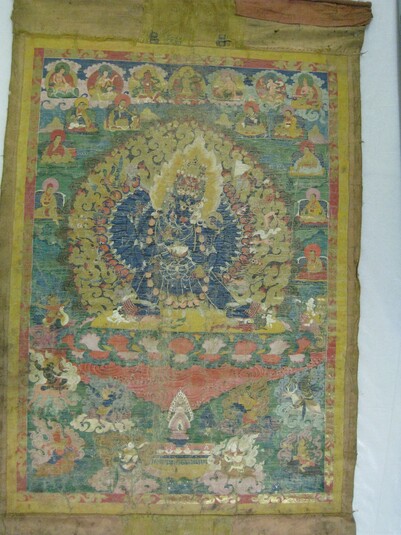
Item: Vajrabhairava (Buddhist Deity) - Solitary (Ekavira)
| Origin Location | Tibet |
|---|---|
| Date Range | 1700 - 1799 |
| Lineages | Sakya and Buddhist |
| Material | Ground Mineral Pigment on Cotton |
| Collection | Field Museum of Natural History |
Classification: Deity
Appearance: Animal-Feature
Gender: Male
Vajrabhairava, Ekavira (Vajra Terror, Solitary Form).
The ferocious Vajrabhairava is black in colour with nine (9) faces, thirty-four (34) hands and sixteen (16) legs. The main face is that of a buffalo, with a red face above and the slightly angry yellow face of Manjushri placed on top. Flames entwine the two horns and shoot fire from the tips. The three right faces, stacked one above the other, are blue, red and yellow and the three left are white, smoky coloured and black. Each face has three large round eyes, bared fangs and each conveys a different emotional expression; yellow hair flows upward like rising flames. The first pair of hands hold a curved knife and skullcup at the heart. The remaining hands hold a multitude of weapons with the last set also holding the fresh outstretched hide of an elephant. Each face is adorned with a crown of five skulls and bone earrings. He wears a snake necklace and a garland of fifty heads. The right legs are bent pressing down on a variety of creatures and gods. The left legs are extended straight and press upon eight birds and various gods. Above a sun disc and multi-coloured lotus blossom rising above a sea of blood he stands in the middle of a mass of yellow flames of pristine awareness. Placed in the foreground is a red triangular offering torma (stylized food) along with other offerings.
Vajrabhairava is a wrathful form of Manjushri and functions as a meditational deity of the Anuttarayoga Classification in Tantric Buddhism. As a principal meditational deity Vajrabhairava, belongs to the Vajrabhairava and Yamari class of tantras and specifically arises from the Vajrabhairava Root Tantra (Tib.: jig je tsa gyu). The Vajrabhairava and Yamari Tantras belong to the method (father) classification of Anuttaryoga Tantra. The practice of Vajrabhairava is common to the three main Sarma Schools of Tibetan Buddhism: Sakya, Kagyu and Gelug. Among the Sakya it is counted as one of the four main tantric deities along with Hevajra, Guhyasamaja and Chakrasamvara (Tib.: gyu de shi). Amongst the various Kagyu Schools the Drigungpa are strong upholders of the practice. In the Gelug School Vajrabhairava is the principal meditational deity taught for Anuttarayoga practice along with the meditational deity Akshobhyavajra Guhyasamaja. There are numerous forms and styles of practice from the very complex with numerous deities to the very concise with a single Heruka form. From amongst the many teaching lineages to enter Tibet it is said that the main ones were those of Rwa Lotsawa and Mal Lotsawa.
Vajrabhairava Profile:
Identity: Manjushri Emanation
Consort: Vajra Vetali
Tantra Class: Anuttarayoga, Method Tantra
Source Text: Vajrabhairava Tantra
Function/activity: Meditational Deity
Metaphor: Death
Special Characteristics:
Appearance: Wrathful with a Buffalo head
Colour: Black/dark blue
Attributes: curved knife & skullcup and 32 additional attributes
The Three Forms of the Consort:
Vetali, the female consort in wrathful aspect embracing Vajrabhairava
Sarasvati, the peaceful aspect of the consort
Oden Barma (Blazing with Light) the protector aspect of the consort
The words Yama, Yamari, Yamantaka, Bhairava and Vajrabhairava appear frequently in all classes of tantric texts and they can refer to an attendant deity, a protector, or as a worldly god beneath the feet of a Buddhist meditational deity (Skt. ishtadevata) such as Vajrayogini, or Chakrasamvara. In those instances Bhairava represents the various negative emotions to be conquered through meditation. Keeping in mind the similarities in name and form it is important not to confuse the various identities, deities and especially the Buddhist Tantric models and systems and to properly understand each in its own place. See the special glossary explaining these technical terms. (For more on this subject see the publication Demonic Divine by Rob Linrothe and Jeff Watt, Rubin Museum of Art, New York, 2004).
Mal Lineage: the lord of Refuge Vajradhara, Arya Manjushri, Acharya Buddha Jnana, Dipamkara Zangpo, Brahmin Shridhara, the pandita and mahasiddha Naropa, Minyam Dorje Kol, the Nepali of Yerang - Bharo Chagdum, Mal Lotsawa Lodro Dragpa, Sachen Kunga Nyingpo (1092-1158), etc.
Jeff Watt 11-2010
Buddhist Deity: Vajrabhairava Main Page
Collection of the Field Museum (Sakya)
Collection of the Field Museum of Natural History (Painting)
Collection of the Field Museum (Best of Collection)
Buddhist Deity: Vajrabhairava (Stacked Faces, Painting)









